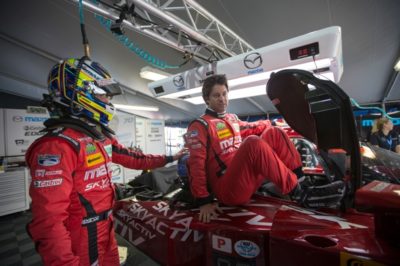Endurance sports car racing is unique in motorsports because multiple drivers share duties to pilot the car to a victory. This creates a very different dynamic (and ego level) than in most categories. This week, Mazda Motorsports Prototype driver Jonathan Bomarito explains the mindset of sharing a ride.
Hi everyone. I’d like to explain what it’s like sharing a race car with your teammate. In sports car racing, you always have a minimum of one teammate and, in some 24 hour races, you could be sharing the car with up to four other drivers. Fast driver changes, car set-up, pace, and motivating each other are some of the aspects to a good driver pairing.
Tristan Nunez is my teammate in the No. 70 SKYACTIV Mazda Prototype. One of the first things you look at with driver pairings is size. Even though there are ways to make most size differences between teammates work, it’s always best to be as similar in size as possible. Tristan and I are similar enough to share the same seat with no insert. This means we can do our driver changes as quickly as possible with the least amount of risk of making mistakes. In endurance racing, being comfortable is very important to minimize soreness and the possibility of cramping.
Drivers are very picky by nature when it comes to car set-up. Some drivers like a very solid rear on the corner entry that will tend to understeer, while another driver could like a very responsive front with zero understeer. If you have two drivers with different styles, it can be very tricky for the engineer to find a balance that both drivers are happy with. The engineer will have to make big compromises to the set-up and in the end, neither driver will be completely happy and confident with the race car. Tristan and I have only been working with each other for a short time, but we could see right away that we were asking the engineer for the same things. This is a crucial part in finding a good driver pairing.
Another aspect is pushing each other on and off the track. Both drivers need to be mature, humble and want to do everything possible to help your teammate be successful. It requires a tremendous amount of teamwork. Comparing and analyzing data acquisition, on-board video and detailed track notes is very important and requires a lot of trust and communication.
Your teammate needs to become a good friend almost immediately. You need to know your teammate extremely well so you know if they’re having a bad day, something is off in their life, they’re not feeling well … anything that will affect performance so the strategy can be altered to maximize your result. That’s the beauty of having two evenly matched drivers who can rely on each other and be top contenders every race weekend.


 ACCESSIBILITY
ACCESSIBILITY